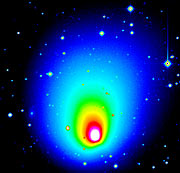Comet Hale-Bopp (February 12, 1998)
 This is a summary of recent developments around this comet; the previous was published on the ESO Web on September 25, 1997. It is based on information received directly by email and also from IAU Circulars and on other Hale-Bopp WWW pages. A complete list of these Updates is also available.
This is a summary of recent developments around this comet; the previous was published on the ESO Web on September 25, 1997. It is based on information received directly by email and also from IAU Circulars and on other Hale-Bopp WWW pages. A complete list of these Updates is also available.
Richard M. West (ESO)
Munich, February 12, 1998
1. Current state
Comet Hale-Bopp is now deep in the southern sky and no longer observable from the northen hemisphere. The latest magnitude estimates put it at about 8.2, i.e. it is too faint to be viewd with the unaided eye. A small tail with a length of about 0.25 deg is visible with bioculars and small telescopes. A more complicated and much larger tail structure was recorded by large telescopes in late december 1997 and early January 1998, cf. the information below.
2. Provisional report from Hale-Bopp Meeting
The First International Hale-Bopp Conference was held on the island of Tenerife during four days in early February. It was very successful, with nearly 150 participants and as many papers and it allowed a thorough discussion about the recent work. Many exciting results were presented and it is now possible to see clearer. Still, much work remains to be done on the very large amount of data obtained.
A brief and provisional overview of some of these has been put together in an accompaning text , based on the conference summary given on the last day. A more comprehensive version with references etc. will appear in due time in the Conference proceedings.
3. Information on IAU Circulars
News have been published on several IAU Circulars since the last Update in this series appeared in September 1997. For instance, visual magnitudes and a new ephemeris were given on nos. 6797 and 6799.
In late December 1997, the comet developed an anti-tail, and the famous `neck-line' tail structure became well visible when the Earth passed through the comet's orbital plane on January 3, 1998. Two IAU Circulars announce related observations:
On no. 6812, (January 23, 1998), G. Garradd (Loomberah, N.S.W., Australia) , reports that CCD images taken from the second half of 1997 Dec. through 1998 Jan. 17.46 UT show an antitail, and the December images additionally show a longer normal dust tail than previously a Jan. 4.
From ESO, and on the same Circular, H. Boehnhardt, O. Hainaut, G. Pizarro , and R. West write: Schmidt telescope exposures of comet C/1995 O1 taken between 1997 Dec. 29 and 1998 Jan. 6 at La Silla show a straight tail about 10" wide that extends both 25' into the sunward side of the nucleus at p.a. 8 deg and at least 4 deg to the anti-solar side at p.a. 188 deg.....The tail/antitail phenomenon is interpreted as due to the presence of large and old dust grains in the cometary dust tail that were released by the nucleus at least 100 days before the observations (or even much earlier). Two of the photos are available on the web as eso9806.
The new developments are confirmed by P. R. Holvorcem ( Departamento de Matematica, Universidade Estadual de Campinas), who on IAU Circular 6814 (January 28, 1998) reports that the straight tail/antitail of C/1995 O1 reported on IAUC 6812 is visible faintly on an image obtained by co-adding three CCD exposures taken around Jan. 23.055 UT with a 0.20-m f/3.3 reflector...
4. Other images
Another Hale-Bopp site by Rodrigo Velásquez has been added to the list of other sites.
A press release eso9726 have been published. They show images of Comet Hale-Bopp, obtained on October 1, on which the different distribution of gas and dust in the coma is visible. Four, perhaps even six, dust jets can be discerned, indicating that the nucleus is still very active at a heliocentric distance of nearly 3 AU.
5. Comet Hale-Bopp on the WWW
Some reflections upon the various `Hale-Bopp' activities on the WWW are available in a poster paper, presented by R. West (ESO) at the Tenerife conference.